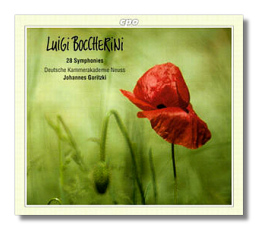
The Internet's Premier Classical Music Source
Related Links
- Boccherini Reviews
- Latest Reviews
- More Reviews
-
By Composer
-
Collections
DVD & Blu-ray
Books
Concert Reviews
Articles/Interviews
Software
Audio
Search Amazon
Recommended Links
Site News
 CD Review
CD Review
Luigi Boccherini

28 Symphonies
- Symphony Op. 10 #4 in C Major, G. 523 (1771)
- 6 Symphonies Op. 12, G. 503-508 (1771)
- 6 Symphonies Op. 21, G. 493-498 (1775)
- 6 Symphonies Op. 35, G. 509-514 (1782)
- 3 Symphonies Op. 37 #1, 3 & 4, G. 515, 517, 518 (1786)
- Symphony Op. 41 in C minor, G. 519 (1788)
- Symphony Op. 42 in D Major, G. 520 (1789)
- Symphony Op. 43 in D Major, G. 521 (1790)
- Symphony Op. 45 #5 in D minor, G. 522 (1792)
- Symphony in D Major, G. 490 (1775)
- Symphony in D Major, G. 500 (1781)
Deutsche Kammerakademi Neuss/Johannes Goritzki
CPO 999401-2 DDD 8CDs
The symphonies of Luigi Boccherini (1743-1805) may sound like those of Franz Joseph Haydn (1732-1809) on a perfunctory first hearing. Both composers create works that eloquently embody the spirit of their era: they contain dazzling forays into rhythmic variety, tight and logical structure, and bold elaboration of thematic material. Both composers admired each other and freely borrowed thematic and structural techniques. At one time, contemporary wags referred to Boccherini as "the wife of Haydn," an unfair appellation certainly, but one with a spot of truth.
But Boccherini's symphonies stood well on their own and endure today because of their inherent good spirits, their charming (although timid) use of polyphony, and most of all, their intense lyricism. In fact, his lyricism is at once his greatest strength and greatest roadblock to growth. He never did sacrifice melodies to delve deeply into drama and polyphony like Haydn. He never went through a Sturm und Drang period; although his symphonies contain dark moments, they are never tragic. We never sense he's creating a work of heroic proportions encompassing pre-Beethovian struggles, like Haydn's (and later Mozart's) symphonies do. While the Andantio in the Op. 45 Symphony is grave and vaguely troubling, the mood quickly dissipates with a reassuring minuet. We never sense that a war or conflict is rumbling in the background as in Haydn's Symphony #100 in G ("Military") or even his Symphony #103 in E Flat Major ("Drum Roll"). There is so much cheer and rococo ornamentation in Boccherini. He even provides a Mediterranean touch in the Symphony in C Major (Op. 10, #4) with the spirited addition of a guitar.
Johannes Goritzki and his Deutsche Kammerakademie Neuss orchestra give consistent and enjoyable readings to these symphonies, never flagging their enthusiasm for his music for an instant. Throughout these twenty-eight works, they provide a picture of Boccherini as a composer of gusto and good living. Perhaps the real difference between Boccherini and Haydn is garlic.
Copyright © 2000, Peter Bates



















